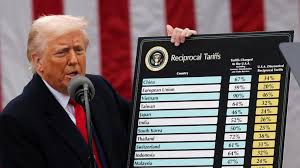
Last week America’s President Donald Trump fulfilled his electoral promise of signing an Executive Order that imposes varying levels of tariffs on 180 countries all around the world. Ghana now faces a baseline tariff rate of 10% on its exports into the world’s biggest economy.
This is the lowest tariff imposed by the Trump administration – Lesotho, a fellow African country, for instance, faces 50% tariffs – but Ghana has been unsettled by the move.
To be sure, there will be negative repercussions for Ghana, a country that now exports somewhere between US$2.4 billion and US$2.7 billion to the United States annually. However, the public reaction by many trade analysts and economic commentators has been completely over the top – yes there will be some degree of threat to the country’s foreign exchange earnings and even more definitely, there will be some job losses, but altogether, the new situation is not a major threat to the Ghanaian economy.
Indeed, properly handled it may present major opportunities.
First of all, government should not be in any hurry to announce retaliatory tariffs immediately as they would serve little purpose. Not only does America not rank among Ghana’s top export markets, but even more importantly, Ghana maintains a healthy trade surplus with that country. Indeed, the imposition of the lowest baseline tariff on Ghana in part reflects America’s relative disinterest in dramatically changing its trade relationship with us. However an immediate, unmeasured retaliation by Ghana could serve to stoke a fire that has barely been lit.
Secondly, the structure of Ghana’s exports to the US means that the tariffs will not significantly reduce our export earnings from that country since the primary exports are cocoa beans and crude oil, two commodities that America direly needs. Indeed, the biggest threat to Ghana is the fate of the many small sized enterprises that sell all sorts of non traditional exports to that country in fragmented volumes and consequently relatively small values. While any reduction in demand for such exports would not dramatically reduce Ghana’s overall export revenues derived from America, there is the real possibility of significant job losses, especially among small enterprises whose exports to the US are their primary source of income.
For such enterprises therefore there is the need to identify and exploit export markets in other parts of the world, which certainly exist; after all, who could have predicted, three decades ago that China would today provide Ghana with its largest export market. Besides, the African Continental Free Trade Agreement (AfCFTA) has opened the door to vastly increased exports, as well as imports, from fellow African countries on preferential terms.
But underlying all this is a crucial opportunity to reduce Ghana’s exposure to the vagaries of global supply chains, as vividly illustrated during the recent COVID 19 pandemic era. Already, the new government in Ghana is subtly shifting emphasis from expansion of non-traditional exports to import substitution as a way of solving the perennial problem of hard currency shortages. A lot of products now facing reduced demand in America due to tariff generated price increases can equally serve as raw materials for agro-processing business and heavier industrial activity back at home.
For those who have seen Ghana’s acceptance of trade liberalization as a shot in its own foot, America’s latest actions are simply a lever through which we can retreat from it.



